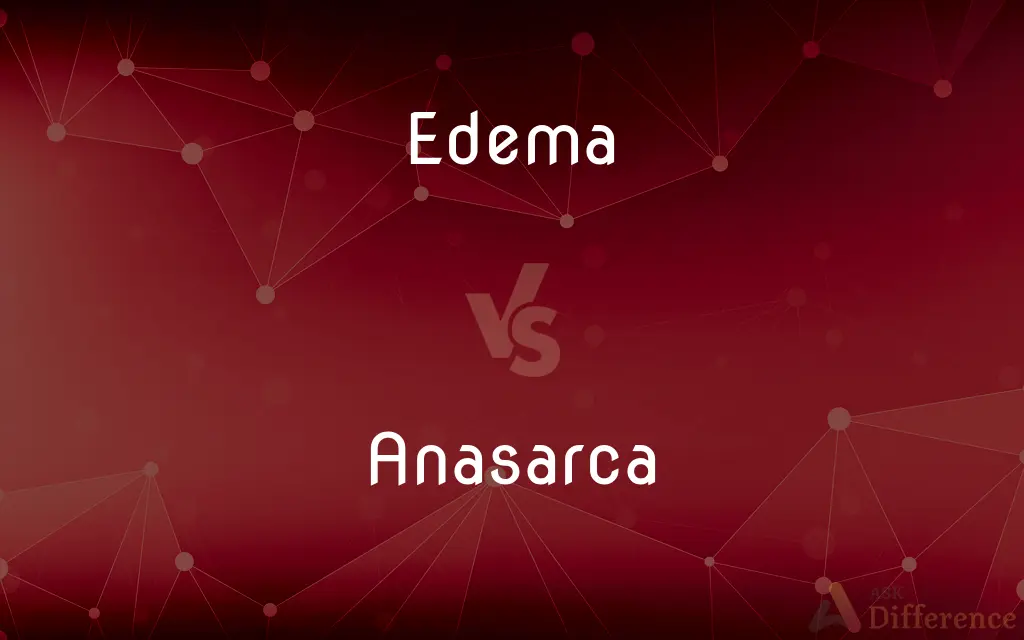Edema vs. Anasarca — What's the Difference?
Edited by Tayyaba Rehman — By Urooj Arif — Updated on March 18, 2024
Edema is the swelling caused by excess fluid in body tissues, localized or affecting a specific area, while anasarca is severe, widespread edema affecting the whole body.

Difference Between Edema and Anasarca
Table of Contents
ADVERTISEMENT
Key Differences
Edema involves the accumulation of fluid in specific body tissues, leading to swelling that can be either localized (affecting a single area) or generalized (affecting a broader area). It can result from various conditions, including heart failure, kidney disease, or sitting for long periods. On the other hand, anasarca is a severe form of edema that results in generalized swelling throughout the entire body and is often indicative of critical underlying health issues, such as severe heart or kidney failure.
The causes of edema can vary widely, ranging from benign conditions like prolonged sitting or standing, to more serious health issues such as liver disease, heart conditions, or chronic venous insufficiency. Whereas anasarca typically signifies more severe systemic failure or disease, such as significant organ failure or severe malnutrition, indicating a critical condition that requires immediate medical attention.
Treatment for edema often depends on addressing the underlying cause, which may involve lifestyle changes, medication to manage symptoms (e.g., diuretics), or treatment of the underlying disease. In contrast, the treatment of anasarca requires more aggressive management of the underlying conditions, possibly including hospitalization, intensive care, or advanced therapies to support vital organ functions and manage the extensive fluid accumulation.
The symptoms of edema include swelling or puffiness of the tissue directly under your skin, stretching or shiny skin, and skin that retains a dimple after being pressed. While anasarca also presents with swelling, its severity is such that it affects the entire body, leading to massive swelling, pain, and difficulty moving or breathing, and can severely impact organ function.
Diagnosing edema may involve physical exams, medical history analysis, and tests like blood tests or imaging studies to identify the underlying cause. Anasarca's diagnosis, while similar in approach, emphasizes identifying critical systemic issues, necessitating more extensive testing to understand the severe underlying conditions.
ADVERTISEMENT
Comparison Chart
Definition
Swelling due to fluid accumulation in specific tissues
Severe, generalized swelling throughout the body
Causes
Varied, from benign to serious health issues
Indicates severe systemic disease or organ failure
Treatment
Depends on underlying cause; often includes medication, lifestyle changes
Requires aggressive management of underlying condition; may include hospitalization
Symptoms
Localized or generalized swelling, shiny skin, dimpling on pressure
Massive, widespread swelling, pain, difficulty moving or breathing
Severity
Can range from mild to severe, depending on the cause and area affected
Extremely severe, often indicative of life-threatening conditions
Compare with Definitions
Edema
Treatment targets the underlying cause, possibly with diuretics.
Diuretics helped reduce her edema significantly.
Anasarca
Often a sign of critical underlying health issues.
His anasarca indicated severe heart failure.
Edema
Swelling due to fluid accumulation in a specific part of the body.
After the flight, she noticed edema in her ankles.
Anasarca
Symptoms include massive swelling and difficulty in moving or breathing.
Anasarca caused her severe discomfort and breathing difficulties.
Edema
Can result from conditions like heart disease or prolonged sitting.
His heart condition caused edema in his legs.
Anasarca
Severe, generalized swelling throughout the entire body.
The patient's anasarca was so severe that it impeded his movement.
Edema
Symptoms include puffiness, shiny skin, and skin that dimples when pressed.
The skin over the swollen area showed a noticeable dimple after pressing.
Anasarca
Diagnosed through extensive testing for systemic diseases.
After several tests, anasarca was diagnosed, pointing to underlying critical conditions.
Edema
Diagnosed through physical exams and medical history.
The doctor diagnosed her swollen feet as edema based on her medical history.
Anasarca
Requires aggressive treatment and possibly hospitalization.
She was hospitalized for anasarca treatment, indicating severe systemic issues.
Edema
Edema, also spelled oedema, and also known as fluid retention, dropsy, hydropsy and swelling, is the build-up of fluid in the body's tissue. Most commonly, the legs or arms are affected.
Anasarca
Anasarca is a severe and generalized form of edema, with subcutaneous tissue swelling throughout the body. Unlike edema, which almost everyone will experience at some time and can be relatively benign, Anasarca is a pathological process reflecting a severe disease state and can involve the cavities of the body in addition to the tissues.
Edema
(Medicine)An excessive accumulation of serous fluid in tissue spaces or a body cavity.
Anasarca
A general accumulation of serous fluid in various tissues and body cavities.
Edema
(Botany)A condition of plants characterized by blisterlike swellings on the leaves or other parts, caused by an accumulation of water.
Anasarca
(medicine) Severe generalised oedema.
Edema
An excessive accumulation of serum in tissue spaces or a body cavity.
Anasarca
Dropsy of the subcutaneous cellular tissue; an effusion of serum into the cellular substance, occasioning a soft, pale, inelastic swelling of the skin.
Edema
A similar swelling in plants caused by excessive accumulation of water.
Anasarca
Generalized edema with accumulation of serum in subcutaneous connective tissue
Edema
Same as œdema.
Edema
Swelling from excessive accumulation of serous fluid in tissue
Common Curiosities
Are there specific tests to diagnose anasarca?
Diagnosis involves extensive testing to identify severe systemic issues, similar to edema but with a focus on critical conditions.
Can edema lead to anasarca?
Yes, if edema is severe and untreated, it can progress to anasarca, especially in the context of systemic disease or organ failure.
Can lifestyle changes prevent edema or anasarca?
Lifestyle changes can help manage or prevent edema but are unlikely to significantly impact anasarca without addressing the severe underlying conditions.
How is anasarca treated?
Anasarca requires aggressive treatment of the underlying condition, which may include hospitalization and intensive care.
Can both edema and anasarca affect organ function?
Yes, while edema can impact the function of specific organs or areas, anasarca can severely affect multiple organ systems.
What is the difference between edema and anasarca?
Edema is the swelling caused by fluid in specific body tissues, while anasarca is a severe, generalized form of edema affecting the entire body.
How do doctors determine the cause of edema or anasarca?
Doctors use a combination of medical history, physical exams, and various diagnostic tests to determine the cause.
How common is anasarca compared to edema?
Anasarca is less common than edema, as it represents a severe and generalized form of fluid accumulation.
What are the first signs of anasarca?
The first signs include rapid and extensive swelling throughout the body, often accompanied by pain and mobility issues.
What role do kidneys play in edema and anasarca?
The kidneys regulate fluid balance in the body; dysfunction can lead to both edema and anasarca due to fluid accumulation.
Is anasarca always a sign of severe illness?
Yes, anasarca typically indicates a life-threatening condition requiring immediate medical attention.
Can medication cause edema or anasarca?
Certain medications can cause edema as a side effect, but anasarca as a medication side effect is extremely rare and would likely involve underlying health issues.
Are there non-medical treatments for edema?
Non-medical treatments for edema include lifestyle modifications and physical therapies, depending on the cause.
Can diet affect edema or anasarca?
Diet can impact edema, particularly regarding salt intake, but anasarca requires more comprehensive medical treatment.
Is there a genetic predisposition to edema or anasarca?
While there's no direct genetic predisposition, certain genetic conditions can increase the risk of diseases that lead to edema or anasarca.
Share Your Discovery

Previous Comparison
Pentagram vs. Pentagon
Next Comparison
Biotope vs. EcotopeAuthor Spotlight
Written by
Urooj ArifUrooj is a skilled content writer at Ask Difference, known for her exceptional ability to simplify complex topics into engaging and informative content. With a passion for research and a flair for clear, concise writing, she consistently delivers articles that resonate with our diverse audience.
Edited by
Tayyaba RehmanTayyaba Rehman is a distinguished writer, currently serving as a primary contributor to askdifference.com. As a researcher in semantics and etymology, Tayyaba's passion for the complexity of languages and their distinctions has found a perfect home on the platform. Tayyaba delves into the intricacies of language, distinguishing between commonly confused words and phrases, thereby providing clarity for readers worldwide.
















































